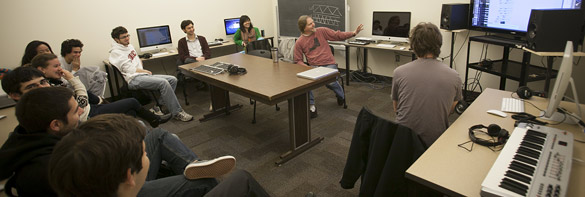Students sweeten sounds in Schwartz Center studio
By Kathy Hovis

Cornell student filmmakers and theater artists can more easily add moody background music, the sounds of elephants charging or other sonic touches to their productions with the Schwartz Center's updated sound studio spaces.
A small composers' studio and adjoining classroom space allow students to "bring more of a focus on sound to projects, whether for theater, film or installations," said Warren Cross, resident sound designer and senior lecturer in the Department of Performing and Media Arts.
"Our new monitor and switching technology allow us to show individual projects to the class more easily, so we can audition and critique work," Cross said.
The room is tuned using diffusive materials to absorb sound and includes a new video monitor, speakers and computers with specialized sound design software, keyboards and a teaching station.
In the new space, students don headphones to work on projects, learning to create and match sound to film/media work, theater and dance. Cross noted that 10 percent of the sound in feature films and 90 percent in action films is done with a technique called Automated Digital Replacement (ADR), meaning that the dialogue is actually added after filming is complete.
"You can imagine that in a movie like 'Transformers,' there is so much noise between the generators running, the people yelling and the cars crashing, that it's impossible to hear any dialogue," he said. "All of that is added after the filming."
Even in older television programs like "Wild Kingdom," animal sounds were added afterward, he said. Called Foley work, this involves reproducing all kinds of sounds, from typing on a keyboard to people walking across a room, he said. Both of these processes are called "sweetening" the sound, fine-tuning it post-production, Cross said.
Students who take sound design classes have varied interests, he said. Some are engineers or computer scientists who want to create sound for video games, others are interested in music, theater or film sound.
Cross will teach a new class in the spring focused on creating sound for multimedia installations and plans a class for fall 2013 for students interested in film scoring.
He also is working with other staff to form a group for students interested in interactive multimedia performance. Called CHIMP (Cornell Hackerspace for Interactive and Multimedia Performers/artists), the group is "a collaboration of like-minded creative technologists." The main contact for the group is Dan Gaibel, Web director for Cornell's Language Resource Center. He can be reached at dg76@cornell.edu.
Kathy Hovis is communications manager in the Department of Performing and Media Arts.
Media Contact
Get Cornell news delivered right to your inbox.
Subscribe